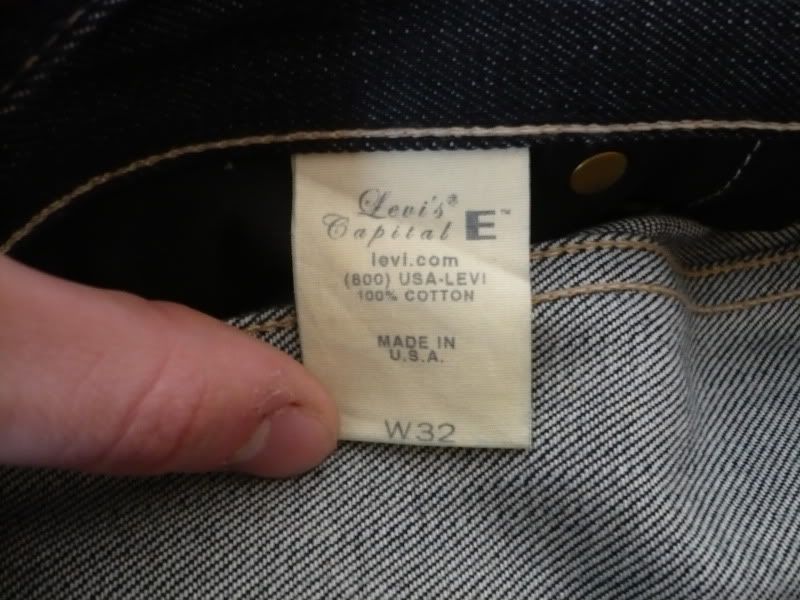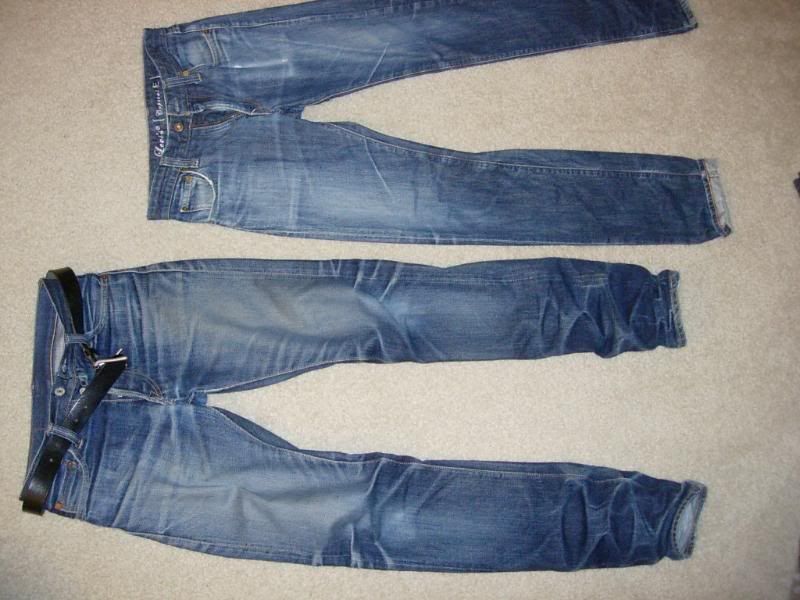-
Posts
87 -
Joined
-
Last visited
Content Type
Profiles
Forums
Events
Gallery
Store
supertorial
Classifieds
Posts posted by yakrian
-
-
A wooden chip that says "Levi's ECO - 100% Organic Cotton" on it. Whatevs.
0 -
"Never Give Up On Love" - Concord Dawn Ft. Tiki
Perfect for running to, once the beat drops.
Though I guess that's any DnB...
0 -
^^^
I'm not sure why that amuses me so much.
0 -
^^^ Thats an awesome comparison shot. Keep it up, man.
0 -
Waste time on SuFu.
Sleep.
Mix Drinks and/or Music.
Karate.
0 -
Akuma, that Farm Tactics stuff looks awesome!
Also, my Levi's Capital-E Eco Twisted Slouch
100% Organic cotton, Made in California.

 0
0 -
Belts
in superdenim
My two cents on this (was thinking about this today):1870-1960: America sets new standards in manufacturing. America pioneers new benchmarks in industrial innovation and design.
1960-present: Oil Crisis. American-made innovation and design fades against new competition from post-war Asian and German markets. Foreign-made goods become competitive or better
1990-present: foreign-made replicas of American-made goods now cheaper. America outsources overseas to remain competitive. US design becomes a parody. US a cheap hooker.
2005-present: US-made goods are revived by trend-setters enamored of an American manufacturing past that is almost forgotten.
The goods these hipsters ignored while in Liberal-Arts college because it was 'townie-wear' is now fashionable because of new trendiness in vintage/sustainable/green/back-to-the-land-move to a-farm in Vermont Thing
US realizes the cheap prostitution it succumbed to. US industry, prompted by trend-forecasting mall-brand money revives old mills and machines. Pottery-Barn tchochkes and Gap pants made in Vietnam become embarrassing to own.
US manufacturers learn new marketing and manufaturing methods and develop new labor philosophies. US learns to market products with "your grandaddy" and "they don't make 'em like this anymore"...US learns how to make shit without using ten gallons of oil per ounce of product. US learns how to sell GREEN! US learns to turn 30 years of punishment under EPA regs into and advantage!! They develop websites that work! America is saved by its own history kept alive by the Japanese and revived by a trend-following bunch of bearded Brooklyn hipsters with disposable income.
It's all about the beard, I guess?
The truth, the whole truth, and nothing but the truth. Thank you for this.
Would rep.
0 -
Belts
in superdenim
i'm saying that if pretty much the exact same thing with the exact same quality and exact same material was used and could be found cheaper, why cling to the more expensive of the 2?For starters, neither myself or kix is trying to throw you out of the thread...It's nothing like that.
But let me give you a very recent example. I'm walking around some of the shops near campus today, and I walk past a shoe-tailor's that has a number of belts outside...One of said belts looks similar to the natural 11oz. Tanner belt we're discussing. Upon closer inspection, though, the leather turned out to be a lot rougher, had no second belt-loop or stitching and you could see where someone had spilled some oil or chemical on the back of the hide. The guy was asking $60.
Now, $60 for a machine-made belt of lower quality leather with crap spilled on it? or $75 + shipping for a hand-made, higher quality leather, and nicer accoutrements. I'd say that's not a difficult call, personally. But honestly, if you could find me a belt made of the same quality and material for less...By all means, I'm a student, I'd take it.
0 -
Looking good, man.
0 -

Jesus Crom. I've gotten into arguments over paying $200-$300 for a pair of raw jeans...And these fuckers are asking $250,000 for a pair that's been washed 13 times.
Go figure.
0 -
Belts
in superdenim
I dunno. I wouldn't pay over $100...That being said, I stand by the idea that you get what you pay for.
0 -

Nice progress. Info on the Capital E's?
0 -
Belts
in superdenim
not paying $82 shipped for a beltHey man, Brave Leather belts are going for that much without shipping...And they're not even as nice as Tanner.
0 -
How chunky is it with the strap? I'm interested, but not if the thing's gonna blow out my pocket...
0 -
Alright, we're back on track with this! Been itching for updates.
0 -
voted.
10char
0 -
In Canada they think of it as a Texas Tuxedo.
As a Canadian, I acknowledge the Texas Tuxedo as Jeans and Denim Shirt. The Canadian Tuxedo is Jeans and Denim Jacket, specifically...'cause its so cold up here a simple shirt won't cut it.
0 -
Alot of the best food is tucked in alleys in places you never would look. Cheap, authentic and tasty. Some of the best foreign food in japan can be found the same way. Of course you can go to famous places and pay big bucks but there is loads of really good food to be found.
Perfect example is Shabu-sen and Zakuro in Ginza. Zakuro serves the same food as Shabu-sen, but looks a little more fancy and has an extra 0 attached to their prices...
In Shibuya area, duck into some alleys near Tower Records and look for Shirube. One of the best izakaya in the city.
As for somewhat rural areas...Head up to Gunma for a day or two. Do some hiking in the mountains then go for a dip in the hot-springs at Kusatsu.
0 -
haha let's be honest, most humanities degrees are an epic fail.
Precisely. Might as well get a degree in something I'll enjoy. Besides, most employers can give you the specific training that you need as OJT. Learning to deal and communicate with other cultures is something that takes a little more time. Either way, say what you will, I'm happy with the education I'm receiving at the moment.
0 -
I think I rather work at a ramenya.
lulz. I'm just giving you what little I know about it. I'm still in the process of getting my East-Asian Studies/Japanese Language degree, myself...but I'm planning to do JET regardless. Sorry I can't be of more help.
0 -
Once you've got your degree, there are tonnes of programs that will let you work in either country. Some pay better than others.
On the Japanese front, there's the JET Programme (I think they're now doing JET in the States, too) that pays fairly well and will set you up comfortably. But only if you have a degree.
As for Korea, a buddy of mine has done both English teaching and translation services and did quite well for himself at them.
Also, learn one and then try some of the other. Japanese and Korean grammar are almost identical. Start with Korean, since Hangul is the harder of the two writing systems...when you learn Japanese, it'll make learning kana that much simpler.
0 -
^^^
Wouldn't have thought of that myself, but now that you mention it...
0 -
ことえり is fucking useless
Amen. Hallelujah. Peanut Butter...
0 -
^^^
Durarara!! is awesome. It doesn't matter where they go with it, as long as Shizuo is throwing shit around Ikebukuro, I'm happy with it.
DURARARARARARARARARARARA!!
0




The Flat Head 3001 World Tour
in superdenim
Posted
Solid update. That flea market looks crazy.